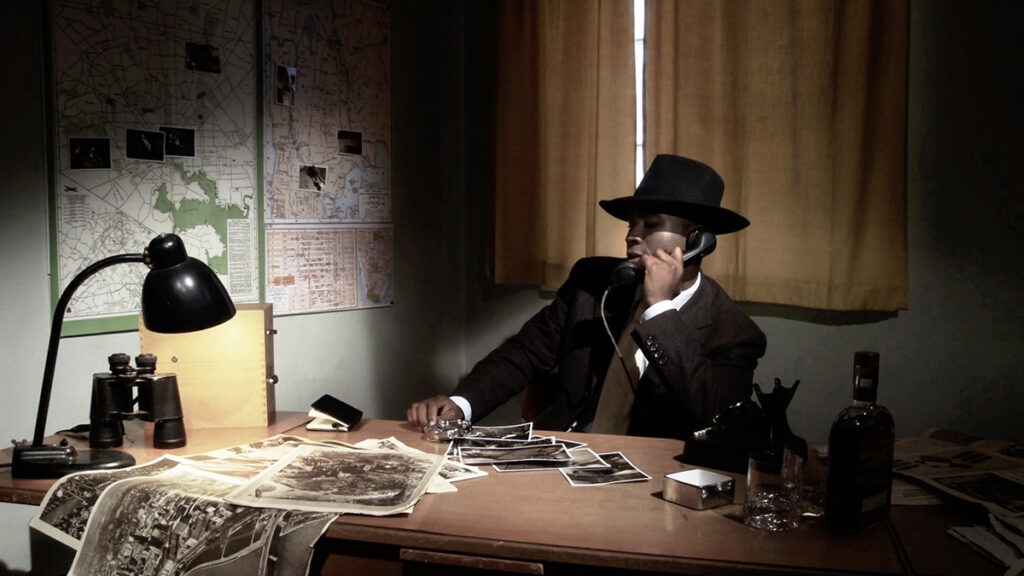Rebecca Ann Tess
A Crime Must Be Committed
April 3 – May 28, 2011

Wir freuen uns am 2. April 2011 um 19.00 Uhr unsere neuen Galerieräume in Berlin mit der zweiten Ausstellung von Rebecca Ann Tess zu eröffnen.
Die Videoinstallation A Crime must be Committed (2010) ist der zweite Teil einer dreiteiligen Serie, die sich mit dem historischen Wandel von Charakterinszenierungen in der europäischen und US-amerikanischen Kino- und Fernsehgeschichte auseinandersetzt. In A Crime must be Committed zitiert und verfremdet Tess genretypische Szenen des Crime und Detektivfilms – unter anderem aus dem Gangsterfilm der 1920er Jahre (Underworld, 1927), dem Film Noir (The Maltese Falcon, 1941), dem Neo-Noir Film (The Detective, 1968), dem Kriminalfilm/Thriller (Die Hard, 1988; Shaft, 1971 und 2000) und der zeitgenössischen Kriminalfilmserie (CSI, ab 2000) – und verfolgt so die historische Entwicklung der Figur des Detektivs und seine Beziehung zu dem Kriminellen sowie die Machtverhältnisse zwischen den Charakteren, welche sich im Laufe der Zeit verschieben.
Das Video verweigert dabei die Chronologie, die sonst die Geschichtsschreibung strukturiert, wobei die Spannung ebenso unaufgelöst bleibt wie der Kriminalfall. Der Loop lässt Anfang und Ende offen und je nachdem wann zu und wieder weggeschaut wird erscheint eine andere Variante der alten Geschichte von Räuber und Gendarm.
Angst ist nicht nur im Detektiv- und Kriminalfilm ein wichtiges dramaturgisches Element sondern taucht im Hollywoodfilm auch häufig dann auf, wenn es gilt das Zielpublikum aus weißen, männlichen Zuschauern in deren Identität zu bestätigen.
Verschiedene Situationen, in denen solche Ängste aufgerufen und abgewehrt werden, zeigt Tess in einer Reihe von Collagen, die hier nun erstmals gezeigt werden. Die Bilder sind auf Acrylglas gedruckt, so dass sie einerseits den Hintergrund durchscheinen lassen und andererseits das frontale Licht die Schatten der Konstellationen auf die Galeriewände projiziert. In diesen Bildobjekten scheinen die Ursprünge des Films und der Fotografie, nämlich Celluloid wie auch das Glasnegativ, auf eigentümliche Weise mit den zeitgenössischen Präsentationsformen von Bildern auf flachen Monitoren verbunden. Es tauchen dabei Charaktere und Figurenkonstellationen auf, in die gesellschaftliche Ängste eingeschrieben wurden. Es sind Ängste, die zu Unterdrückung und Diskriminierung führen, die hier aber nun vervielfacht und ins Monströse überhöht ein Eigenleben in diesen rahmenlosen Fenstern zur medialen Traumwelt entwickeln.
We are proud to present – on the occasion of the opening of our new space in Berlin – the second solo exhibition A Crime Must Be Comitted by Rebecca Ann Tess on April 2, 2011 at 7 pm.
The video installation A Crime must be Committed is the second instalment of a three-part series, addressing the historical shifts in presentation of characters in European and US film and television history. In A Crime must be Committed Tess cites and alters typical scenes of the crime and detective film genre, such as gangster movies of the 1920s, (Underworld, 1927), film noir (The Maltese Falcon, 1941) neo-noir, (The Detective, 1968), crime thrillers, (Die Hard, 1988; Shaft, 1971 and 2000), and the contemporary criminal investigation se ries (CSI, from 2000). The artist follows the historical development of the detective fi gure and his relationship to the criminal, as well as the power relation between the cha racters that changes over time. The video refuses to follow a chronological order that normally structures historiography. The tension as well as the case of the cri mi nal film remain unresolved. The loop leaves beginning and end undefined and de pen ding at what moment the viewer starts and ends watching a different version of the traditional cops and robbers story appears.
Fear is not only an important dramaturgical component of a detective and crime film, it also often plays a role in Hollywood productions, in order to affirm the tar ge ted white male in his identity. Different situations in which those fears are invoked and repelled are the topic of Tess’ new series of collages exhibited for the first time. The pictures are printed on acrylic glass, so that the background shines through and the frontal light casts shadows on the wall of the gallery. These pictorial objects seem to connect the origin of film and photography, namely celluloid and glass ne ga tive, and the contemporary way of presenting images on flat screens. Characters and constellations of figures appear in which fears of the society are inscribed. These are fears that lead to oppression and discrimination and that are here mul ti plied and intensified to the monstrous. They develop a life of their own in the frame less windows to the media dream world.